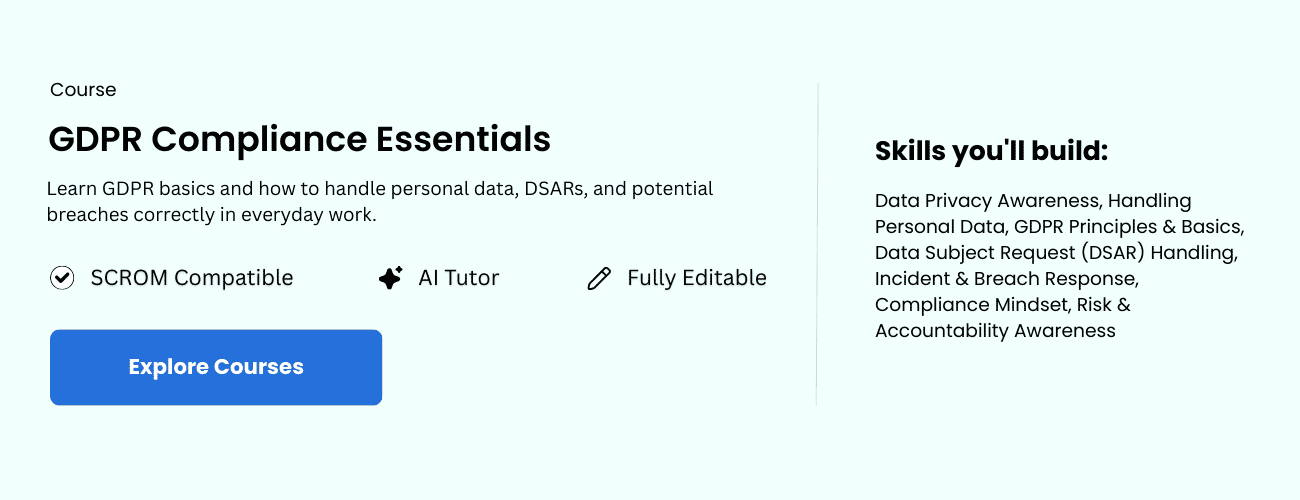Introduction to Information Security Compliance Training
In today’s rapidly evolving digital landscape, organizations encounter an increasing array of cyber threats that can jeopardize sensitive data, disrupt operations, and harm their reputation. To mitigate these risks, complying with industry regulations and standards has become essential to effective information security management.
Information security compliance training plays a vital role by ensuring employees and stakeholders understand their responsibilities in protecting organizational data. As cyber threats grow more sophisticated—from phishing schemes to ransomware attacks—training enables staff to recognize, prevent, and respond swiftly to security incidents.
Frameworks like the General Data Protection Regulation (GDPR), Health Insurance Portability and Accountability Act (HIPAA), and international standards such as ISO/IEC 27001 impose strict data handling and protection requirements. Non-compliance can result in hefty fines, legal penalties, and loss of customer trust. Therefore, integrating comprehensive security training into organizational policies fosters a culture of security awareness and regulatory adherence.
Effective compliance training enhances cybersecurity posture by promoting consistent best practices across all organizational levels. It builds accountability and trust—crucial elements in today’s data-driven economy. As threats evolve, ongoing education and proactive training are essential to maintain resilience and compliance with emerging standards.
Core Components of an Effective Information Security Compliance Framework
A strong compliance framework is critical for safeguarding sensitive data, ensuring adherence to regulations, and cultivating a security-centric culture. Developing such a framework involves integrating key elements that work together to identify risks, set standards, and facilitate continuous improvement. Here are the foundational components vital for a resilient compliance program.

Establishing Comprehensive Policies and Procedures
At the heart of any compliance framework are clear policies and procedures. These documents define expectations and provide guidelines for security practices. Effective policies should align with relevant regulations like GDPR, HIPAA, or PCI DSS, depending on the industry and location. They cover access control, data protection, incident response, and employee conduct.
- Clarity and accessibility: Policies must be written clearly and communicated effectively to all staff.
- Regular updates: As threats and regulations change, policies should be periodically reviewed and revised.
- Enforcement mechanisms: Procedures for verifying compliance and applying disciplinary actions encourage accountability.
Conducting Thorough Risk Assessments
Risk assessments identify vulnerabilities and help prioritize mitigation efforts. A comprehensive evaluation considers potential threats to information assets, the likelihood of attacks, and their potential impacts.
- Regular assessments: Conducted at least annually or after significant organizational changes.
- Utilize established frameworks: Methods like NIST SP 800-30 or ISO 27005 ensure consistency.
- Document findings: Maintain detailed reports to track vulnerabilities and guide decision-making.
Defining Roles, Responsibilities, and Accountability
Clear role definition ensures everyone understands their part in maintaining compliance. Assigning accountability fosters a proactive security culture and streamlines operations.
- Role-based access controls (RBAC): Limits permissions based on individual job functions, reducing insider threats.
- Responsibility matrices: Assign clear responsibilities for compliance tasks, audits, and incident response.
- Training and awareness: Continuous education emphasizes staff responsibilities and policy updates.
Utilizing Technology Tools to Support Compliance and Training
Modern technology tools streamline compliance processes, manage documentation, and facilitate ongoing training efforts.
- GRC platforms: Centralize policy management, risk assessments, and audit workflows.
- SIEM systems: Enable real-time monitoring, threat detection, and compliance tracking.
- Learning Management Systems (LMS): Deliver continuous training, assessments, and awareness campaigns effectively.
Integrating Elements for Continuous Improvement
Compliance frameworks must be dynamic, adapting to emerging threats and regulatory updates. Regular audits, feedback loops, and advanced technology help keep the framework relevant and effective.
In summary, establishing comprehensive policies, conducting risk assessments, clarifying roles, and leveraging technological tools are fundamental for a resilient compliance system. Organizations heavily investing in these areas can better manage risks, demonstrate regulatory compliance, and foster stakeholder trust.
Implementing, Measuring, and Improving Compliance Training
Strategic compliance training fosters a culture of integrity by helping employees understand their roles in adhering to regulations. Designing engaging, role-specific programs, measuring their impact accurately, and continuously refining content are key to maintaining effective compliance efforts in a changing environment.
Designing Engaging, Role-Specific Compliance Training Programs
One-size-fits-all training rarely delivers optimal results. Tailoring programs to specific roles and responsibilities enhances relevance and effectiveness.
Understanding Role-Specific Risks and Responsibilities
Different roles face unique compliance challenges. For example, finance teams need training on AML regulations, while customer service staff require guidance on data privacy laws like GDPR. Conducting risk assessments helps identify these needs and informs targeted content creation.
Developing Interactive and Relevant Content
Engagement depends on relevance and interaction. Incorporate realistic scenarios, case studies, and problem-solving exercises that reflect daily tasks. Use simulations and quizzes to build active learning, making compliance concepts more memorable and applicable.
Leveraging Various Delivery Methods
Different roles prefer different learning formats—online courses, classroom training, videos, or mobile modules. A blended approach maximizes participation and retention by accommodating diverse preferences.
Assessing Training Effectiveness Using KPIs
Measuring the success of training programs helps identify strengths and areas for improvement.
- Completion Rates: Percentage of employees finishing modules on time.
- Assessment Scores: Pass/fail metrics on quizzes to evaluate knowledge retention.
- Behavioral Changes: Monitoring for reductions in compliance violations.
- Incident Reduction: Tracking decline in security breaches post-training.
Using LMS analytics and feedback surveys provides data to refine and improve training content continually.
Continuously Updating Content to Address New Threats and Regulatory Changes
The compliance landscape is ever-changing. Organizations must stay abreast of legislative updates and emerging threats, updating training materials regularly to ensure ongoing relevance.
- Monitoring Regulatory Changes: Keep track of updates from authorities like regulators and standards bodies.
- Learning from Incidents and Feedback: Use audit findings and employee input to identify gaps.
- Leveraging Technology: Adopt adaptive learning platforms that facilitate quick updates and microlearning on hot topics.
This proactive approach ensures employees remain informed and capable of addressing new risks, thereby strengthening overall compliance efforts.
Best Practices, Trends, and Future Directions in Information Security Compliance
To stay ahead in the constantly shifting realm of information security compliance, organizations must adopt a proactive mindset. Embracing emerging standards, leveraging innovative technologies like automation and artificial intelligence (AI), and fostering a security-first culture are essential strategies for future readiness.
Emerging Standards and Regulations Shaping the Future
Compliance standards are continually updated to address new threats. Recent developments include the revised NIST Cybersecurity Framework (CSF), the European Union’s Digital Operational Resilience Act (DORA), and the US Cybersecurity Maturity Model Certification (CMMC). These frameworks emphasize adaptive risk management and resilience, raising organizational security benchmarks.
Remaining informed about these changes enables organizations to update controls and policies proactively, safeguarding their reputation and stakeholder trust.
The Role of Automation and Artificial Intelligence in Compliance
Automation and AI are transforming compliance workflows. Automated tools facilitate continuous risk monitoring, real-time incident detection, and faster response times, reducing manual effort and human error.
AI-driven systems like SIEM tools analyze vast data streams to identify anomalies and security threats promptly. Moreover, AI enhances audit readiness through real-time documentation management. Integrating these advanced technologies improves compliance posture while aligning with regulations emphasizing proactive risk mitigation.
Cultivating a Security-First Culture
Technological controls alone are insufficient. Building a security-first mindset involves ongoing employee training, visible leadership commitment, transparent policies, and incentives for secure behaviors. Employees trained to recognize and respond to threats become vital in reducing human vulnerabilities and strengthening overall security.
Practical Steps for Enhancing Compliance Training
Organizations should incorporate simulation exercises and gamification to boost engagement. AI-personalized learning paths, regular updates aligned with new threats, and a culture of continuous education are critical for adapting to future risks. These strategies keep the workforce vigilant and compliant, regardless of evolving regulatory landscapes.
Future Directions in Security Compliance
The future will likely see increased use of automation, real-time monitoring, privacy-enhancing technologies, and zero-trust architectures. Innovations such as blockchain-based audit trails and AI ethics standards will further redefine compliance frameworks. Organizations that invest in these emerging paradigms and foster adaptive learning environments will be best equipped to face upcoming cybersecurity challenges.
Conclusion: Empowering IT Teams through Robust Compliance Training
In today’s digital era, a robust compliance framework is crucial for safeguarding assets and preserving stakeholder trust. Effective training equips IT teams with the skills needed to identify, prevent, and respond to threats proactively. By nurturing a culture of continuous learning and accountability, organizations enhance their security posture and lower the risk of costly breaches.
Investing in comprehensive, role-specific training inspires vigilance, encourages best practices, and aligns teams with organizational security goals. Ultimately, a well-trained IT workforce transforms compliance from a regulatory requirement into a strategic advantage—safeguarding valuable resources and supporting long-term success.












